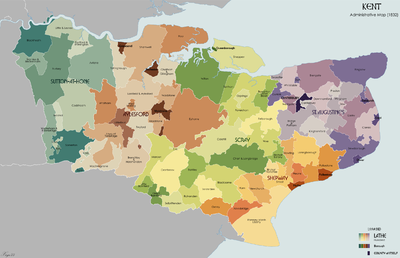Lathes of Kent

The Lathes of Kent are the main division of that county, and of ancient origin, similar to the hundreds found in other counties, though each lathe is itself divided into hundreds. Neighbouring Sussex also has a unique division, the Rapes of Sussex, also divided into hundreds.
There are five lathes:
Origin
When the lathes were established n Kent is unknown. It is assumed that they were an ancient division of the Kingdom of Kent, perhaps established as early as the 6th century.[1] There exists a widespread belief that lathes originally formed around the royal settlements of the Kingdom of Kent. [2]
The lathes certainly predate the Norman Conquest, and were known in Old English as læð: a charter refers to On westan Cænt ðær ðæt land and ðæt læð to lið. The laws of Edward the Confessor, in Latin include the observation: In quibusdam vero provinciis Anglice vocabatur léð, quod isti dicunt tithinge and the Laws of King Henry I refer to officials known as a leidegrevei ('lathe-reeves').
Etymologically, the word lathe (læþ) may derive from a Germanic root meaning "land" or "landed possession". One Old English source inclides the words: ne gyrne ic ðínes ne læðes ne landes (usually rendered "I desire of thine neither lea nor land"), and an equivalent phrase is found in Old Norse, with the word lað.
History
By the late eleventh century, West Kent appears to have comprised three lathes:
- Lathe of Aylesford
- Lathe of Milton
- Lathe of Sutton
- while East Kent comprised four lathes:
- Lathe of Borough
- Lathe of Eastry
- Lathe of Lympne
- Lathe of Wye[3]
Of these, Sutton-at-Hone and Milton sometimes ranked as half-lathes.[4]
In the thirteenth century Kent had reached its total of five lathes:
- the lathes of Borough and Eastry merged to form the Lathe of St Augustine
- the lathe of Lympne underwent a name-change to become the Lathe of Shepway
- the lathes Milton and Wye merged to form the Lathe of Scray
- the Lathe of Aylesford survived unchanged.[4]
The lathe was an important administrative, judicial and taxation unit for 600 years after the Domesday Book. The functions of lathe and hundreds were somewhat similar, with a lathe covering a much wider area. The Sheriff toured the county twice yearly attending on the lathes, in the case of Sutton at Hone, possibly at Shire Hall. The lathe was responsible for the raising of aids and subsidies for the Militia. However the lathe court became anomalous as it fell between the hundredal courts below and the justices of the county (in petty and quarter sessions) above.[5] In time it died out.
List of the lathes
The area of each lathe in 1831 was as follows:[6]
| Lathe | Area (acres) |
Area (sq.miles) |
|---|---|---|
| Lathe of Saint Augustine | 166,760 | 260 |
| Lathe of Shepway | 127,380 | 199 |
| Lathe of Scray | 260,510 | 407 |
| Lathe of Aylesford | 244,150 | 381 |
| Lathe of Sutton at Hone | 173,440 | 271 |
| TOTAL | 972,240 | 1,519 |
See also
References
- ↑ Dartford Country - The Story Of The Hundred Of Axstane by Geoff Porteus, 1985, ISBN 9780860232032 (page 13)
- ↑ Vision of Britain: Lathe
- ↑ Domesdaybook.net: Lathe
- ↑ 4.0 4.1 J. E. A. Jolliffe, "The Hidation of Kent", in English Historical Review, Vol. 44, No. 176 (Oct., 1929), pp. 612-618 [1]
- ↑ Dartford Country - The Story Of The Hundred Of Axstane by G. Porteus (page 32)
- ↑ "The Hidation of Kent", in English Historical Review, Vol. 44, No. 176 (Oct., 1929), p.612, by J. E. A. Jolliffe